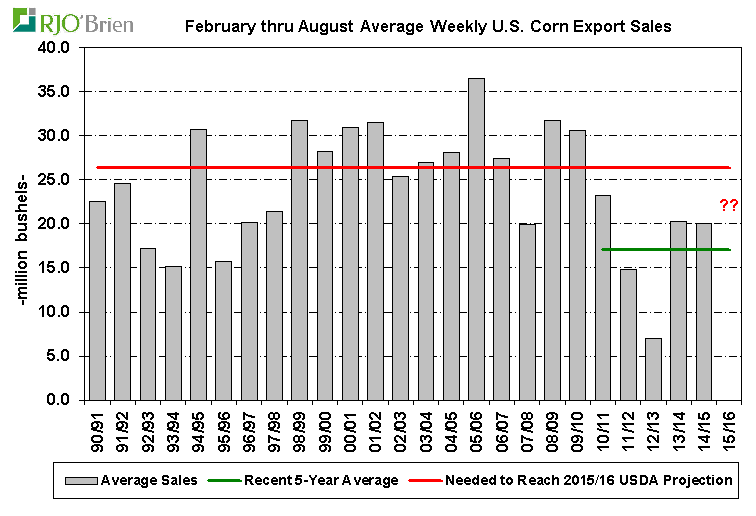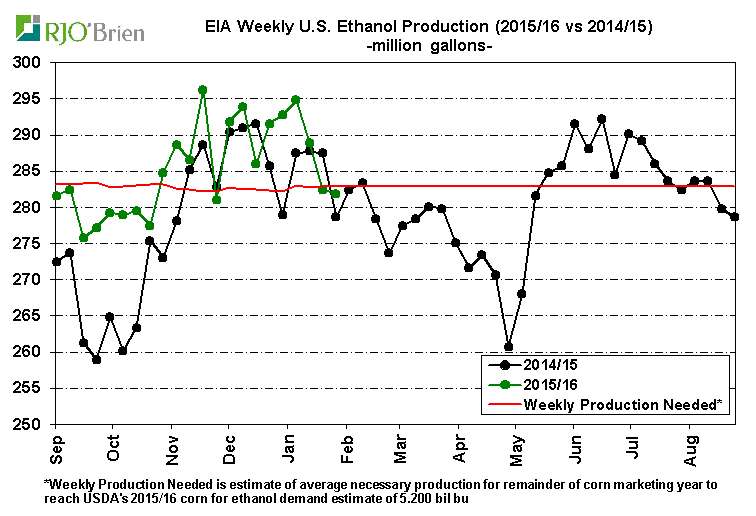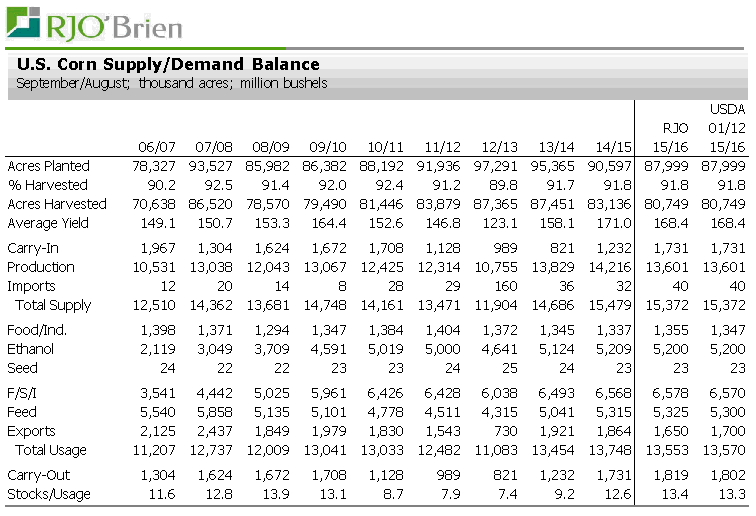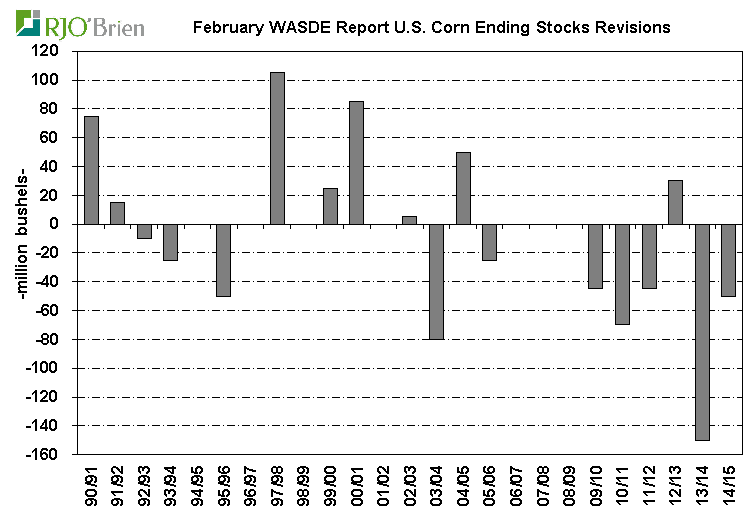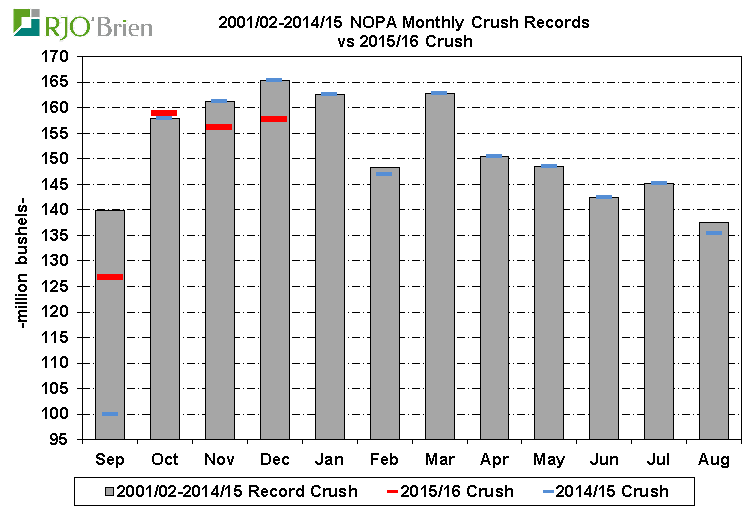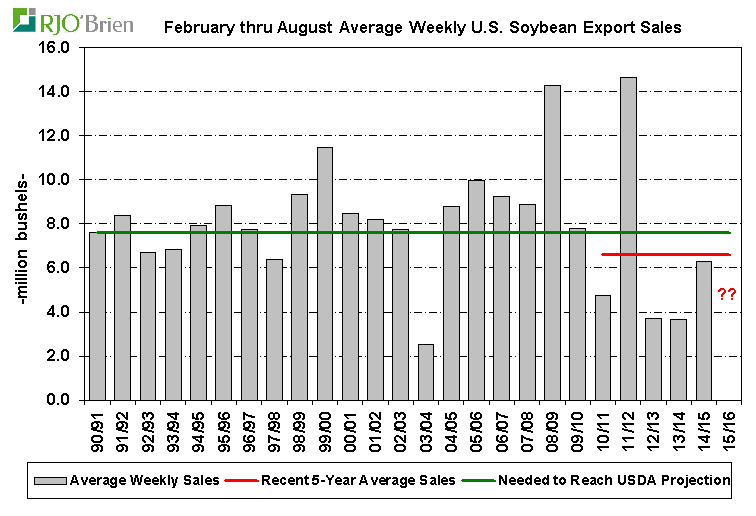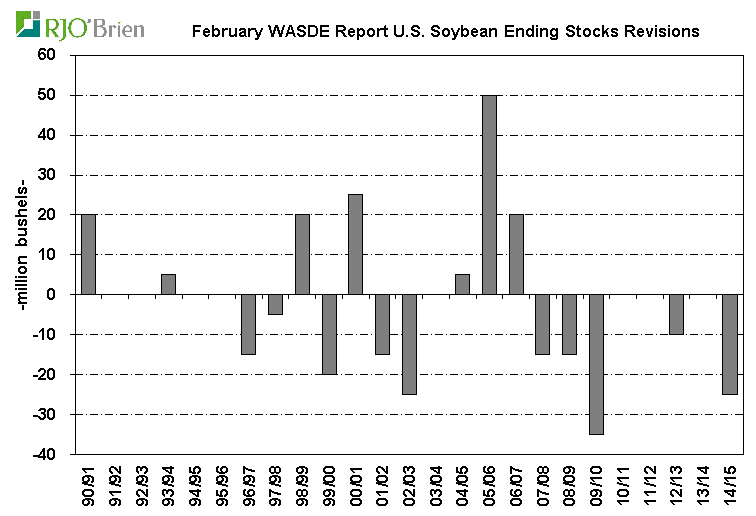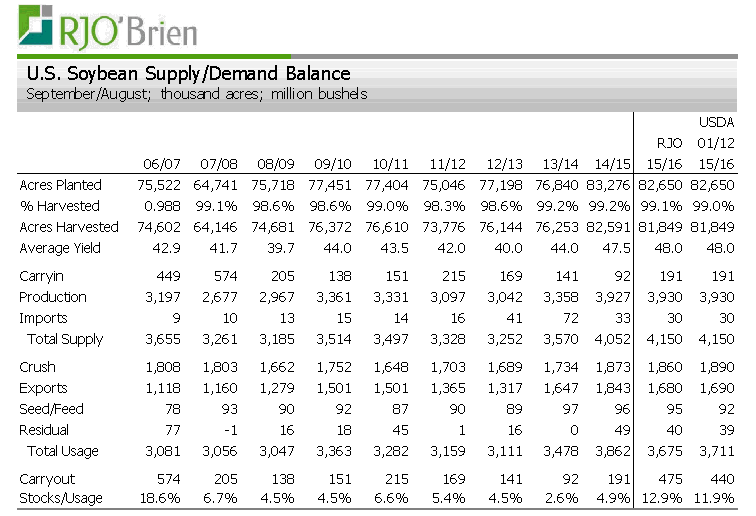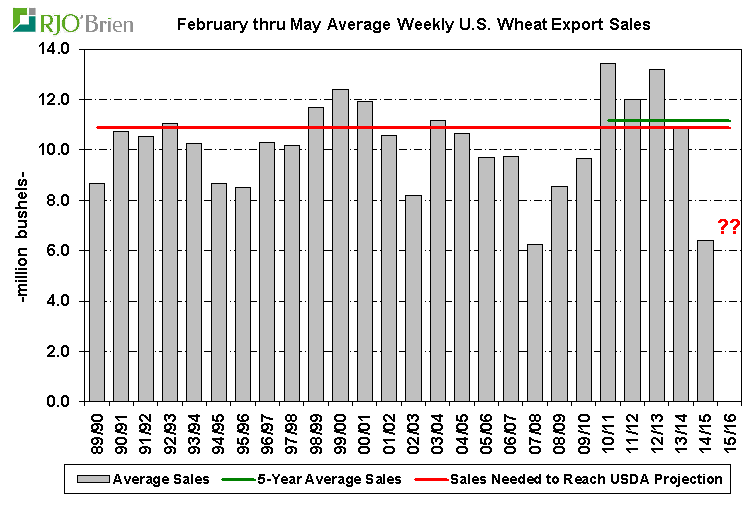Today, Tuesday, February 9, the USDA will release their monthly WASDE supply/demand balance sheet revisions, as well as updated global crop estimates. The February report typically is not a major market influence, but with ongoing U.S. demand concerns across corn, wheat and soybeans, as well as some minor weather discussions of late regarding South American production prospects, it will still be an important update ahead of the USDA’s Ag Outlook Forum February 25-26.
Corn
The general theme regarding corn continues to be overall malaise towards the U.S. corn demand situation. Simply put, there is not a single demand component right now presenting any constructive/bullish signals to the market as export, ethanol and feed demand all remain tepid at best. USDA traditionally has made regular demand-side revisions in the February WASDE report, but they do tend to be somewhat limited in nature. That could be the case again this time around as arguments can be made that 2015/16 exports and corn for ethanol usage could prove lower than current USDA estimates, but given the seasonal nature of demand, they could just as well decide to hold the line at this time, as well.
U.S. corn export demand, both sales and shipments, has lagged relative to the USDA’s annual export projection since the start of the 2015/16 marketing year. The degree of the shortfalls has prompted USDA to lower their corn export estimate in five of the eight monthly reports subsequent to the first 2015/16 estimate in May, including the last three consecutive months. There is little doubt the risk regarding the USDA’s 1.700 billion bushel export projection clearly remains to the downside, but there is the possibility USDA could take a brief breather on downward adjustment this month.
The only reason we feel USDA may hold the line on their export estimate this month is the fact that sales in recent weeks have been quite good, averaging 40.7 million bushels/week over the last three weeks vs just 25.5 million/week over the previous 7-week period. Heading into this month’s report, there definitely has been an uptick in business. Compared to the roughly 26.3 million bushels/week in which sales need to average through the end of the marketing year, they have obviously been solid of late.
However, when stepping back and looking at the big picture, the view becomes much more pessimistic. Total commitments of 954 million bushels are down 25% from last year and are the 2nd lowest as of late January of the last 13 years. More importantly, the hole that has been dug requires corn sales to average roughly 26 million bushels/week over the remainder of the marketing year in order for exports to be able to reach the USDA’s 1.700 billion bushel export projection. As seen in the following chart, not a single year’s sales over the last four years has averaged more than 20 million bushels/week from this point forward, while average February-August sales over the last five years have been just 17.1 million bushels/week. Both of those references are obviously substantially below the level of “needed†sales based on the USDA’s current export projection – strongly pointing to the likelihood of further downward revisions being made at some point. We’re currently estimating 2015/16 U.S. corn exports at 1.650 billion bushels and feel they could even prove lower when all is said and done.
The corn for ethanol situation appears a bit less clear cut to us. We do not feel USDA will make a revision to their 5.200 billion bushel estimate next week, as production so far has easily been keeping up with the USDA’s annual demand estimate. However, there are some longer-term concerns with the likelihood of production continuing to run mostly in line with year ago levels, which is needed based on the USDA’s current corn demand estimate, given the historically high stocks situation and less-than-spectacular margin structure. As seen in the following chart, production since September has generally run above year ago level and the “needed†pace, so we look for no change on Tuesday.
The USDA’s export and ethanol numbers are likely be the focus this month, with no change expected in the USDA’s feed/residual usage estimate at this time. USDA rarely makes feed/residual revisions in the February WASDE report, having done so only once in the last 11 years, being last year’s 125 million bushel cut. Recent livestock reports have not provided any reason to expect an atypical revision this month.
At this time, our most notable difference in the US corn balance sheet with the USDA is on exports. We’re currently estimating 2015/16 exports at 1.650 billion bushels vs USDA last at 1.700 billion. We are estimating feed/residual usage a bit higher than USDA at 5.325 billion bushels (5.300 billion USDA) with the recent Cattle Inventory report showing numbers up solidly on the year and larger than expected, while obviously feed costs remain rather low and competitive with DDGS value at least for now. All told, we estimate 2015/16 U.S. corn ending stocks at 1.819 billion bushels vs USDA last at 1.802 billion. The average trade estimate of those specifically estimating this month’s USDA revision is 1.809 billion bushels, while the combination of all trade estimates has an average idea of 1.799 billion bushels.
In the “for what it’s worth†category, USDA has made regular balance sheet revisions in the February report, with the majority in recent years being downward revisions in ending stocks as seen below. Again, though, that would not be our expectation for next Tuesday’s report.
We feel there is a solid potential USDA will raise their South American corn crop estimates next week, as well. With remaining mostly decent, and good rains expected in Argentina this weekend, combined with CONAB’s recent increase in the Brazilian crop and increased corn area expectations in Argentina on late planting activity, we feel there could be slight increases in both estimates. Potentially being a bit offsetting to any upward South American revisions, though, the USDA attaché in Ukraine recently lowered their corn export estimate so USDA may follow suit, as well. For now, we don’t see world balance sheet revisions being notable enough to materially impact the market.
Soybeans
The focus on the U.S. soybean balance sheet may be shifting a bit away from the export situation to the crush outlook as recent data shows crush activity well below year ago levels. With crush margins under pressure and the USDA’s current 1.890 billion bushel crush estimate requiring nearly record-strong crushing activity for the remainder of the marketing year, we feel USDA will need to make a downward revision this month.
November crush was down 3% from last year, while December crush was down nearly 5% on the year. Sept-Dec U.S.-wide soybean crush totaled 638 million bushels, modestly above last year’s estimated 613 million bushels (official US-wide data didn’t start being put out by USDA until May). With the USDA’s 1.890 billion bushel crush estimate being 17 million bushels above last year, Jan-Aug crush would need to total 1.253 billion bushels vs last year’s 1.260 billion during the same time frame. Of the 8 months last year from January through August, six were all-time record crush levels – a rather unlikely situation to be repeated this year with the large South American crops on the way, soybean meal export commitments down 18% on the year and crush margins under pressure. Soybean oil export demand has been solid (commitments up 18%) and reduced palm oil production continues to get plenty of focus in the market, but is unlikely be enough of a catalyst to push crush activity to near record levels in the months ahead. Accordingly, we are estimating 2015/16 U.S. soybean crush at 1.860 billion bushels, 30 million below the USDA.
We also have concerns about the USDA’s 1.690 billion bushel export projection, but feel there is a bit more uncertainty whether a revision needs to be made this month. Prior to this week’s Export Sales report, which saw net cancellations of 1.6 million bushels, the export situation was progressing at least decently enough to argue USDA could leave their projection unchanged. Total commitments were down 9.5% from last year vs the USDA’s export estimate reflecting ideas of an 8.3% cut in exports. However, while one week certainly does not indicate a notable change in export prospects, the timing of the net cancellations, while moving into a very quick seasonally-declining sales period, does raise warning flags a bit more.
Looking forward, in order to reach the USDA’s 1.690 billion bushel export projection, soybean sales will need to average roughly 7.6 million bushels/week through the end of August. While that sounds like it would be very easy to achieve in context of sales seen in earlier stages of the marketing year, it is far from actuality. As seen in the following chart, last year’s sales from this point forward averaged just 6.3 million bushels/week, while 2012/13 and 2013/14 sales during February-August averaged just 3.7 million bushels/week in both years. Only one of the last five years has seen soybean sales meet or exceed the current “needed†pace for this year’s USDA target – with that being 2011/12 when South American crops notably reduced due to weather issues. Clearly that is not the case this year. The picture of whether USDA needs to or will make an export revision this month is far from clear, but the potential that final 2015/16 exports will prove lower than the USDA’s current 1.690 billion bushel estimate appears a bit more likely. We are estimating 2015/16 exports slightly below the USDA at 1.680 billion bushels, but will be watching the sales pace over the next four weeks very closely as those sales could have a decided influence on final exports as March-August sales typically run at very minimal levels.
Based on our demand ideas, we estimate 2015/16 U.S. soybean ending stock at 475 million bushels vs USDA last at 440 million, but not necessarily for a revision of that magnitude this month. The market is not expecting much change this month as the average estimate of those specifically looking at next week’s report is 445 million bushels, while the overall average estimate is 447 million bushels. USDA has only revised soybean ending stocks in two of the last five February WASDE reports, both to the downside, while the overall bias in February ending stocks revisions in February certainly has been to the downside over the last eight years.
Wheat
The focus of the U.S. wheat balance sheet remains squarely on the export situation, with the prospects of reaching the USDA’s 800 million bushel export projection appearing quite daunting, as well. Over the last several months, wheat sales have been far from encouraging and have been mostly minimally-routine in nature. Weeks of very poor 2-3 million bushels in sales have been offset by modest weeks of 12-13 million bushels in sales. That has generally supported ideas that the USDA’s export target is still attainable as sales averaged 10.0 million bushels/week over the last 11 weeks, a pace right in line with “needed†sales. However, with the calendar quickly turning pages and the marketing year winding down, maintaining the same sales pace seen of late over the last four months of the marketing year could be a difficult task given the seasonality of sales to ease in the final months. Last year is a perfect example as sales during the most-recent 11-week period averaged a respectable 13.9 million bushels/week, but fell to just 6.4 million/week during February-May.
In order to reach the USDA’s export projection, sales will need to average roughly 10.8 million bushels/week over the remaining 17 weeks of 2015/16, a massive 70% above last year’s average sales from this point forward. Additionally, while Feb-May sales in 2010/11, 2011/12 and 2012/13 all exceeded the “needed†pace of this year’s sales, those years’ exports were all substantially larger than this year’s, ranging from 1.0-1.3 billion bushels. Looking further back, we can see that only one of the previous nine years’ Feb-May average sales paces met the current “needed†pace for 2015/16. With total commitments currently down more than 17% from last year, with the USDA estimating annual exports to be down just 6% on the year, while the “needed†pace of sales is solidly above most recent years’ sales activity in Feb-May, we feel exports will fall short of the USDA’s target. We’re currently estimating 2015/16 exports at 785 million bushels vs USDA last at 800 million and feel they could end up being closer to 775 million in the end.
We are also expecting 2015/16 U.S. wheat feed/residual usage to prove slightly below the USDA’s 150 million bushel estimate, as we’re at 140 million, but would not expect USDA to make another revision until after the March 31 Grain Stocks report.
With our lower export and feed/residual usage estimate, we see 2015/16 U.S. wheat ending stocks at 968 million bushels vs USDA last at 941 million. The average trade estimate of those specifically looking at next week’s report is 947 million bushels, while the overall, combined average trade estimate is 945 million bushels.

